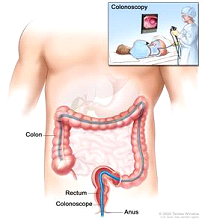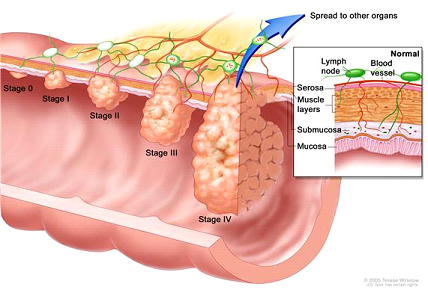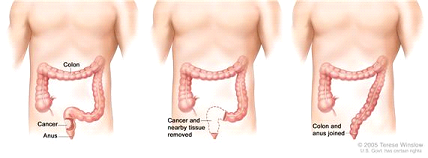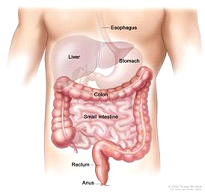Rectal Cancer
Rectal cancer is a disease in which malignant (cancer) cells form in the tissues of the rectum.
The rectum is part of the body’s digestive system. The digestive system removes and processes nutrients (vitamins, minerals, carbohydrates, fats, proteins, and water) from foods and helps pass waste material out of the body. The digestive system is made up of the esophagus, stomach, and the small and large intestines. The first 6 feet of the large intestine are called the large bowel or colon. The last 6 inches are the rectum and the anal canal. The anal canal ends at the anus (the opening of the large intestine to the outside of the body).
Age and family history can affect the risk of developing rectal cancer.
- Being aged 40 or older.
- Having certain hereditary conditions, such as familial adenomatous polyposis (FAP) and hereditary nonpolyposis colon cancer (HNPCC or Lynch syndrome).
Having a personal history of any of the following:
- Colorectal cancer.
- Polyps (small pieces of bulging tissue) in the colon or rectum.
- Cancer of the ovary, endometrium, or breast.
- Having a parent, brother, sister, or child with a history of colorectal cancer or polyps.
Possible signs of rectal cancer include a change in bowel habits or blood in the stool.
These and other symptoms may be caused by rectal cancer. Other conditions may cause the same symptoms. A doctor should be consulted if any of the following problems occur:
A change in bowel habits.
- Diarrhea.
- Constipation.
- Feeling that the bowel does not empty completely.
Stools that are narrower or have a different shape than usual.
- Blood (either bright red or very dark) in the stool.
- General abdominal discomfort (frequent gas pains, bloating, fullness, or cramps).
- Change in appetite.
- Weight loss for no known reason.
- Feeling very tired.
Tests that examine the rectum and colon are used to detect (find) and diagnose rectal cancer.
Tests used to diagnose rectal cancer include the following:
- Physical exam and history: An exam of the body to check general signs of health, including checking for signs of disease, such as lumps or anything else that seems unusual. A history of the patient’s health habits and past illnesses and treatments will also be taken.
- Digital rectal exam (DRE): An exam of the rectum. The doctor or nurse inserts a lubricated, gloved finger into the lower part of the rectum to feel for lumps or anything else that seems unusual. In women, the vagina may also be examined.
- Proctoscopy: An exam of the rectum using a proctoscope, inserted into the rectum. A proctoscope is a thin, tube-like instrument with a light and a lens for viewing. It may also have a tool to remove tissue to be checked under a microscope for signs of disease.
- Colonoscopy: A procedure to look inside the rectum and colon for polyps (small pieces of bulging tissue), abnormal areas, or cancer. A colonoscope is a thin, tube-like instrument with a light and a lens for viewing. It may also have a tool to remove polyps or tissue samples, which are checked under a microscope for signs of cancer.

Colonoscopy. A thin, lighted tube is inserted through the anus and rectum and into the colon to look for abnormal areas.
- Biopsy: The removal of cells or tissues so they can be viewed under a microscope to check for signs of cancer. Tumor tissue that is removed during the biopsy may be checked to see if the patient is likely to have the gene mutation that causes HNPCC. This may help to plan treatment.
The following tests may be used:
- Reverse-transcription polymerase chain reaction (RT-PCR) test: A laboratory test in which cells in a sample of tissue are studied using chemicals to look for certain changes in the structure or function of genes.
- Immunohistochemistry study: A laboratory test in which a substance such as an antibody, dye, or radioisotope is added to a sample of tissue to test for certain antigens. This type of study is used to tell the difference between different types of cancer.
- Carcinoembryonic antigen (CEA) assay: A test that measures the level of CEA in the blood. CEA is released into the bloodstream from both cancer cells and normal cells. When found in higher than normal amounts, it can be a sign of rectal cancer or other conditions
Certain factors affect prognosis (chance of recovery) and treatment options.
The prognosis (chance of recovery) and treatment options depend on the following:
- The stage of the cancer (whether it affects the inner lining of the rectum only, involves the whole rectum, or has spread to lymph nodes, nearby organs, or other places in the body).
- Whether the tumor has spread into or through the bowel wall.
- Where the cancer is found in the rectum.
- Whether the bowel is blocked or has a hole in it.
- Whether all of the tumor can be removed by surgery.
- The patient’s general health.
- Whether the cancer has just been diagnosed or has recurred (come back).
Stages of Rectal Cancer
After rectal cancer has been diagnosed, tests are done to find out if cancer cells have spread within the rectum or to other parts of the body.
The process used to find out whether cancer has spread within the rectum or to other parts of the body is called staging. The information gathered from the staging process determines the stage of the disease. It is important to know the stage in order to plan treatment. The following tests and procedures may be used in the staging process:
- Chest x-ray: An x-ray of the organs and bones inside the chest. An x-ray is a type of energy beam that can go through the body and onto film, making a picture of areas inside the body.
- CT scan (CAT scan): A procedure that makes a series of detailed pictures of areas inside the body, taken from different angles. The pictures are made by a computer linked to an x-ray machine. A dye may be injected into a vein or swallowed to help the organs or tissues show up more clearly. This procedure is also called computed tomography, computerized tomography, or computerized axial tomography.
- MRI (magnetic resonance imaging): A procedure that uses a magnet, radio waves, and a computer to make a series of detailed pictures of areas inside the body. This procedure is also called nuclear magnetic resonance imaging (NMRI).
- Endoscopic ultrasound (EUS): A procedure in which an endoscope or rigid probe is inserted into the body through the rectum. The endoscope or probe has a light and a lens for viewing. A device at the end is used to bounce high-energy sound waves (ultrasound) off internal tissues or organs and make echoes. The echoes form a picture of body tissues called a sonogram. This procedure is also called endosonography.
- PET scan (positron emission tomography scan): A procedure to find malignant tumor cells in the body. A small amount of radioactive glucose (sugar) is injected into a vein. The PET scanner rotates around the body and makes a picture of where glucose is being used in the body. Malignant tumor cells show up brighter in the picture because they are more active and take up more glucose than normal cells do.
- Carcinoembryonic antigen (CEA) assay: A test that measures the level of CEA in the blood. CEA is released into the bloodstream from both cancer cells and normal cells. When found in higher than normal amounts, it can be a sign of rectal cancer or other conditions.
There are three ways that cancer spreads in the body.
The three ways that cancer spreads in the body are:
- Through tissue. Cancer invades the surrounding normal tissue.
- Through the lymph system. Cancer invades the lymph system and travels through the lymph vessels to other places in the body.
- Through the blood. Cancer invades the veins and capillaries and travels through the blood to other places in the body.
When cancer cells break away from the primary (original) tumor and travel through the lymph or blood to other places in the body, another (secondary) tumor may form. This process is called metastasis. The secondary (metastatic) tumor is the same type of cancer as the primary tumor. For example, if breast cancer spreads to the bones, the cancer cells in the bones are actually breast cancer cells. The disease is metastatic breast cancer, not bone cancer.
The following stages are used for rectal cancer:

As rectal cancer progresses from Stage 0 to Stage IV, the cancer cells grow through the layers of the rectum wall and spread to lymph nodes and other organs.
Stage 0 (Carcinoma in Situ)
In stage 0, abnormal cells are found in the innermost lining of the rectum. These abnormal cells may become cancer and spread into nearby normal tissue. Stage 0 is also called carcinoma in situ.
Stage I
In stage I, cancer has formed and spread beyond the innermost lining of the rectum to the second and third layers and involves the inside wall of the rectum, but it has not spread to the outer wall of the rectum or outside the rectum. Stage I rectal cancer is sometimes called Dukes A rectal cancer.
Stage II
In stage II, cancer has spread outside the rectum to nearby tissue, but it has not gone into the lymph nodes (small, bean-shaped structures found throughout the body that filter substances in a fluid called lymph and help fight infection and disease). Stage II rectal cancer is sometimes called Dukes B rectal cancer.
Stage III
In stage III, cancer has spread to nearby lymph nodes, but it has not spread to other parts of the body. Stage III rectal cancer is sometimes called Dukes C rectal cancer.
Stage IV
In stage IV, cancer has spread to other parts of the body, such as the liver, lungs, or ovaries. Stage IV rectal cancer is sometimes called Dukes D rectal cancer.
Recurrent Rectal Cancer
Recurrent rectal cancer is cancer that has recurred (come back) after it has been treated. The cancer may come back in the rectum or in other parts of the body, such as the colon, pelvis, liver, or lungs.
Treatment Option Overview
There are different types of treatment for patients with rectal cancer.
Different types of treatment are available for patients with rectal cancer. Some treatments are standard (the currently used treatment).
Three types of standard treatment are used:
Surgery
Surgery is the most common treatment for all stages of rectal cancer. The cancer is removed using one of the following types of surgery:
- Polypectomy: If the cancer is found in a polyp (a small piece of bulging tissue), the polyp is often removed during a colonoscopy.
- Local excision: If the cancer is found on the inside surface of the rectum and has not spread into the wall of the rectum, the cancer and a small amount of surrounding healthy tissue is removed.
- Resection: If the cancer has spread into the wall of the rectum, the section of the rectum with cancer and nearby healthy tissue is removed. Sometimes the tissue between the rectum and the abdominal wall is also removed. The lymph nodes near the rectum are removed and checked under a microscope for signs of cancer.
- Pelvic exenteration: If the cancer has spread to other organs near the rectum, the lower colon, rectum, and bladder are removed. In women, the cervix, vagina, ovaries, and nearby lymph nodes may be removed. In men, the prostate may be removed. Artificial openings (stoma) are made for urine and stool to flow from the body to a collection bag.
After the cancer is removed, the surgeon will either:
- do an anastomosis (sew the healthy parts of the rectum together, sew the remaining rectum to the colon, or sew the colon to the anus);

Rectal cancer surgery with anastomosis. The rectum and part of the colon are removed, and then the colon and anus are joined.
- or
- make a stoma (an opening) from the rectum to the outside of the body for waste to pass through. This procedure is done if the cancer is too close to the anus and is called a colostomy. A bag is placed around the stoma to collect the waste. Sometimes the colostomy is needed only until the rectum has healed, and then it can be reversed. If the entire rectum is removed, however, the colostomy may be permanent.
Radiation therapy or chemotherapy may be given before surgery to shrink the tumor, make it easier to remove the cancer, and lessen problems with bowel control after surgery. Treatment given before surgery is called neoadjuvant therapy. Even if all the cancer that can be seen at the time of the operation is removed, some patients may be given radiation therapy or chemotherapy after surgery to kill any cancer cells that are left. Treatment given after the surgery, to lower the risk that the cancer will come back, is called adjuvant therapy.
Radiation therapy
Radiation therapy is a cancer treatment that uses high-energy x-rays or other types of radiation to kill cancer cells. There are two types of radiation therapy. External radiation therapy uses a machine outside the body to send radiation toward the cancer. Internal radiation therapy uses a radioactive substance sealed in needles, seeds, wires, or catheters that are placed directly into or near the cancer. The way the radiation therapy is given depends on the type and stage of the cancer being treated.
Chemotherapy
Chemotherapy is a cancer treatment that uses drugs to stop the growth of cancer cells, either by killing the cells or by stopping the cells from dividing. When chemotherapy is taken by mouth or injected into a vein or muscle, the drugs enter the bloodstream and can reach cancer cells throughout the body (systemic chemotherapy). When chemotherapy is placed directly in the spinal column, an organ, or a body cavity such as the abdomen, the drugs mainly affect cancer cells in those areas (regional chemotherapy). The way the chemotherapy is given depends on the type and stage of the cancer being treated.
Targeted therapy
Targeted therapy is a type of treatment that uses drugs or other substances to identify and attack specific cancer cells without harming normal cells. Monoclonal antibody therapy is a type of targeted therapy being studied in the treatment of rectal cancer.
Monoclonal antibody therapy uses antibodies made in the laboratory from a single type of immune system cell. These antibodies can identify substances on cancer cells or normal substances that may help cancer cells grow. The antibodies attach to the substances and kill the cancer cells, block their growth, or keep them from spreading. Monoclonal antibodies are given by infusion. They may be used alone or to carry drugs, toxins, or radioactive material directly to cancer cells.
Treatment Options by Stage
Stage 0 (Carcinoma in Situ)
Treatment of stage 0 may include the following:
- Simple polypectomy.
- Local excision.
- Resection (when the tumor is too large to remove by local excision).
- Internal or external radiation therapy.
Stage I Rectal Cancer
Treatment of stage I rectal cancer may include the following:
- Local excision.
- Resection.
- Resection with radiation therapy and chemotherapy before or after surgery.
Stage II Rectal Cancer
Treatment of stage II rectal cancer may include the following:
- Resection plus a combination of chemotherapy and radiation therapy before or after surgery.
- Resection with or without chemotherapy after surgery.
Stage III Rectal Cancer
Treatment of stage III rectal cancer may include the following:
- Resection plus a combination of chemotherapy and radiation therapy before or after surgery.
- Resection with or without chemotherapy after surgery.
Stage IV and Recurrent Rectal Cancer
Treatment of stage IV and recurrent rectal cancer may include the following:
- Resection with or without a combination of radiation therapy and chemotherapy before surgery.
- Resection or pelvic exenteration, as palliative therapy to relieve symptoms and improve the quality of life
- Radiation therapy, chemotherapy, or a combination of both, as palliative therapy to relieve symptoms and improve the quality of life.
- Chemotherapy to control the growth of the tumor.
- Placement of a stent to help keep the rectum open if it is partly blocked by the tumor, as palliative therapy to relieve symptoms and improve the quality of life.
- Systemic chemotherapy with or without monoclonal antibody therapy, such as bevacizumab.
Treatment of rectal cancer that has spread to other organs depends on which organ the cancer has spread to.
Treatment for areas of cancer that have spread to the liver includes the following:
- Regional or systemic chemotherapy.
- Internal radiation therapy.
- Surgery to remove the tumor with or without chemotherapy before surgery.
0) Treatment for areas of cancer that has spread to the lung or ovaries is surgery.
